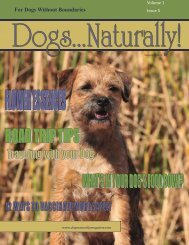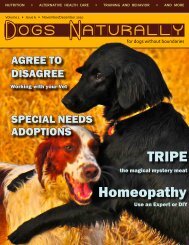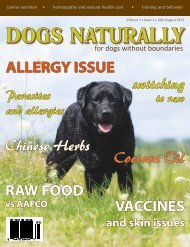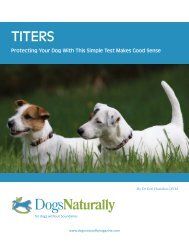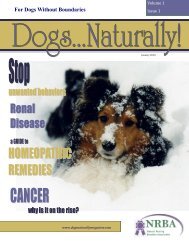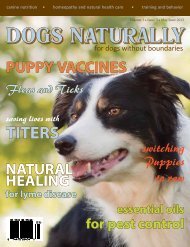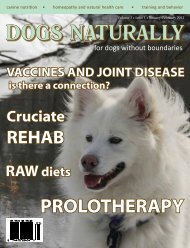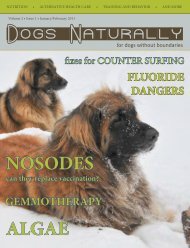July/August 2010 - Dogs Naturally Magazine
July/August 2010 - Dogs Naturally Magazine
July/August 2010 - Dogs Naturally Magazine
Create successful ePaper yourself
Turn your PDF publications into a flip-book with our unique Google optimized e-Paper software.
meat and milk from farmed animals fed<br />
organic feed and allowed to graze on organically<br />
improved soils, contain far more<br />
essential nutrients than conventionally<br />
produced foods**. And they suffer from<br />
far fewer viral and bacterial diseases which<br />
pose a serious public health concern today<br />
because of the intensive, concentrated<br />
animal production systems of the poultry,<br />
dairy and meat industry’s ‘factory farms.’<br />
The billions of pounds of offal that is recycled<br />
into pet food and farm animal feed is<br />
the bedrock of the main stream pet food<br />
industry. But it is a hazardous waste. Bacterial<br />
contamination, as with Salmonella, can<br />
be so difficult to control that Mars Pet care<br />
decided to permanently close one of its pet<br />
food manufacturing facilities in Everson,<br />
Pa in 2008 because the entire plant could<br />
not be effectively sanitized. There had been<br />
repeated recalls of contaminated dry dog<br />
and cat food, associated with nearly 80<br />
reported cases of human illness.<br />
Another form of offal is termed "byproducts"<br />
which are presumed heavily<br />
contaminated with harmful bacteria, and is<br />
therefore subjected to high temperature<br />
and pressure sterilization and then slow<br />
cooking to evaporate off all moisture. The<br />
resultant solid is ground into a meal of<br />
essentially heat-denatured protein of little<br />
nutritive value. It loses more amino acids<br />
by evaporation, and others by cross-<br />
linkage into an indigestible product. Beef<br />
by-products have less protein than chicken<br />
by-products, and the actual digestible protein<br />
is significantly lower than the calculated<br />
‘protein’ content of the manufactured<br />
foods.<br />
Time for Change<br />
There is already a rush-to-market special<br />
and expensive, prescribed diets to help<br />
obese pets lose weight, along with an approved<br />
prescription-only diet pill for obese<br />
pets. Many veterinarians see this as a legitimate,<br />
profit-making business. There is a<br />
plethora of special prescription diets to<br />
help pets with a host of illnesses, such as<br />
allergies and digestive and urinary tract<br />
problems. But compared to simply transitioning<br />
cats and dogs onto a more biologically<br />
appropriate, whole-food diet with<br />
specific supplements and health restoring<br />
nutraceuticals as needed, these costly<br />
manufactured diets are of very limited<br />
value. Their scientific validity and medical<br />
efficacy are also questionable, especially the<br />
low-cal, high fiber weight loss formulations.<br />
The veterinary profession is as yet behind,<br />
rather than leading, as it ought, the human<br />
medical profession, in addressing a host of<br />
health problems arising from manufactured<br />
pet foods, in part because of its ties to industry<br />
as an organized profession, colleges<br />
of which a richly endowed by the pet food<br />
industry: and in part because of indoctrination<br />
as students, that manufactured pet<br />
foods are scientifically formulated, animal<br />
tested, and provide complete and balanced<br />
nutrition for the health and maintenance of<br />
cats and dogs. There is much more to the<br />
basic ingredients and misleading terminology<br />
on the bag and can labels of these<br />
mainstream, main-street pet foods that the<br />
public trusts, no thanks to professional dog<br />
and cat performance events and other dog<br />
and cat shows, local, national, and international,<br />
that the pet food industry helps<br />
underwrite !<br />
Commercial pet foods that people buy are<br />
a major factor in this obesity epidemic as<br />
well as a host of other health problems that<br />
are in part due to ignorance, overfeeding,<br />
and sheer convenience; and to the belief,<br />
shared, it would seem, by many veterinarians,<br />
that high cereal diets are not a significant<br />
contributing factor. Yet once informed,<br />
many pet owners will readily even<br />
cook home-prepared, wholesome, biologically<br />
appropriate meals for their animal<br />
companions, and attest to the almost immediate<br />
benefits observed in their animals’<br />
demeanor and vitality. Fortunately, new<br />
approaches and solutions are on the hori-<br />
“The billions of pounds<br />
of offal that is recycled<br />
into pet food and farm<br />
animal feed is<br />
the bedrock of the main<br />
stream pet food industry.<br />
But it is a hazardous<br />
waste.”<br />
zon. This necessitates an understanding of<br />
how nutrients act and interact at the molecular<br />
level. Accordingly, nutrition research<br />
has shifted from epidemiology and<br />
physiology to molecular biology and genetics.<br />
Diets for animals should be designed<br />
and tailored to the genetic profile of individuals<br />
in order to optimize physiological<br />
homeostasis, disease prevention and treatment,<br />
and promote desired athletic, obedience<br />
or reproductive performances.<br />
For example, a series of specialized semimoist<br />
canned pet food formulas containing<br />
all human grade and organic food ingredients<br />
is now in clinical trials in Italy. These<br />
diets act as cleansing foods for the bowel<br />
and specific organs (e.g. liver and kidney)<br />
of pets with sub-acute and chronic illnesses.<br />
The specific needs of these animals<br />
are determined by applying the principle of<br />
nutrigenomics, where optimal nutrition can<br />
be designed based on an individual’s<br />
unique genetic makeup or genotype. The<br />
resulting food formula is termed the<br />
“molecular dietary signature”, and is<br />
formulated to restore the animal to health.<br />
The Codes of Practice for the Welfare of<br />
Cats and of <strong>Dogs</strong> established by the UK<br />
Government’s DEFRA (Department of<br />
Environment, Food and Rural Affairs)<br />
opens up pet owners to prosecution under<br />
the Animal Welfare Act (potentially<br />
facing up to 12 months in jail and a fine of<br />
up to 20,000 pounds sterling) if they<br />
allow their animals to become overweight/<br />
obese.<br />
www.dogsnaturallymagazine.com <strong>July</strong>/<strong>August</strong> <strong>2010</strong> | 23



